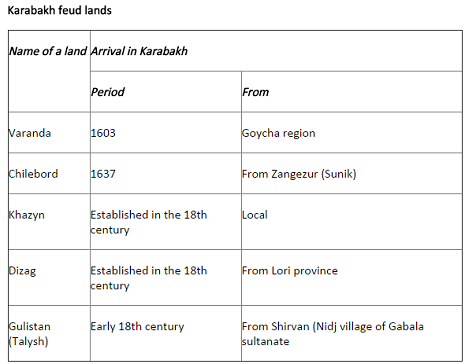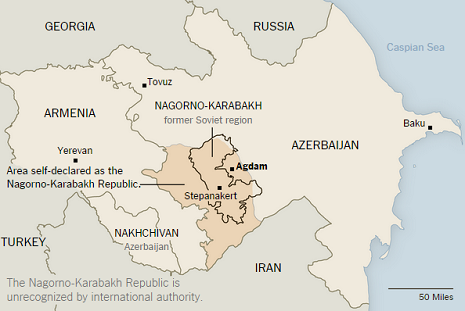He also involved Panah ali khan best known as Panahali bey Sarydjaly Djavanshir, who distinguished himself in every action, was famed and unconquerable in any battle and brave in all the wars with Nadir Rum»s troops (the wars with Osmanly empire in 1730th are implied here -Y.M, K.S). Yet after the Mughan congress Nadir laid punishment on those Karabakhians who did not recognize his power and exiled Muslim population to Afghanistan and Khorasan.
Panakhali»s brother Farzali khan, who protested against these measures was put to death. In period of the Shakh staying in Khorasan, Panakhali bey took the occasion and run away to Karabakh province together with his relatives and closes in 1737-1738. Shah informed about his escape sent couriers after him to prevent him from running away. Nadir shah instructed the leaders of Azerbaijan, Ganja, Tiflis and Shirvan to catch Panah khan wherever they see him and send to the shah»s residence. Though by the order of the shah Panah ali and his family were tormented and set a penalty, that did not work.
Thus, Panah ali khan dodged the responsibility to subdue to Nadir shah and bid to rule his native Karabakh in the most democratic way. As a result, an independent Azeri state-Karabakh khanate established following the death of Nadir shah.
After the declaration of the establishment of independent Karabakh khanate the main goal was to strengthen it. The first measure taken by Panakhali was to return those Muslims driven by Nadir shah to their native land. The return of displaced families and their resettlement of their native land strengthened Karabakh khanate. The future khan of Karabakh 15 year-old Ibragimkhalil was among those who had been first to return.
In period of Karabakh khanate establishment it did not comprise cities as Tebriz, Ardebil, Ganja, Shamakhy, Baky, Nakhichevan, Sheki, Derbend. However, the existence of such politico-economic centers would play a great role in the further development of the khanate. Beside military-political works Panah Ali also made a great progress in the military installations and establishment of towns.
One of the first steps taken in this sphere was the construction of the Bayaty tower named after the ancient Azeri-Turkish tribes bayats in 1748. "The khan assembled his family, relatives and aged men there. The people surrounding him and those who heard about his progress and kind treatment moved to the Bayaty tower from Tebriz and Ardebil.
Panakh khan»s activity in the sphere of creation of an independent state promoted his official recognition. "Mirza Djamal wrote: "Adyl shah»s order on the attachment of the title of "khan" to Panakh Ali and on his appointment the ruler of Karabakh khanate along with valuable dressing-gowns, golden saddled horses and a sword designed with precious stones were brought to the tower Bayaty by the close man of Serdar Amir Aslan in 1161 by the Muslim calendar, in 1745 by Christian calendar (1748 is correct).
In fact Adil shah»s order was a behindhand document. The real title had been deserved much earlier than the order and regardless of it.
An unsuccessful raid of Sheki khanate to Karabakh played a great role in the recognition of Panah Alia as a leader of Karabakh khanate. Sheki khan Hadjy Chelebi, following his unsuccessful Bayaty battle announced: "Panah Ali has previously been a silver without coin. But we came and attached him this coin and went away" (or "Pahah Ali declared him khan while I confirmed it by my defeat").
These words of Hadji Cheleby turning to a popular saying had even much power than Adil shah»s order. Ahmed bey Djavanshir wrote:"…After the victory (The Bayaty battle-Y.M, K.S) the legend about Panah Ali»s courage subdued all Muslim tribes, residing in Karabakh, to Panah Ali with no resistance".
At the same time the Bayaty battle proved the vulnerability of the tower to further historical events. Therefore, it was necessary to construct a new one. Mirza Adygozel bey wrote: "Panah Ali khan built a tower in Ternekut best known as Shahbulaghy. He also constructed Mosques, houses and bazaars and public baths from stones and limestone. After the works were completed he settled there in 1165 (1751)".
The Kurekchay agreement
With the strengthening of Panah khan the feudal lords-monarchs, supporting scarcity, increased their subversive activity. It was necessary to prevent that by some military methods. Otherwise, the khanate would lose its territorial integrity. The original sources also confirm that.
Mir Mehdi Khazani wrote impartially: "The five of Karabakh districts have been separated and each acquired its own name…". Mirza Adygozel bey wrote about the Karabakh feuds-meliks: "Dizag is one of these feuds. Its ruler is Melik Yegan. He escaped from Lori and in period of Nadir»s ruling he was appointed the melik and gained respect by an order of the shah.
The second is in Varan. Melik Shahnezer was its ruler. He is of a more ancient family and has bigger inheritance. His ancestors were the aristocrats of Goycha. Then they escaped and came to Varan province and lost their heads from the wealth they had in their lands.
The third is Khachyn. Its is ruled by the son of Hasan Djalalyan. Their majesty designed the power in a proper way and became a ruler. This family which died of this ruling career was not the independent ruler of the region. At last the state flag of the late Panah khan Djavanshir and the sun lightened every corner of Karabakh province. At that time the Khyndyrystan Melik Mirza khan by the order of these immortal state officials minted coins in the name of… After that his son Allahverdi and grandson Melik Gehreman also glorified their country.
The fourth is Chilebord district. Its ruler was Allahqulu. His ancestors were from Maghaviz. They came and became the rulers of Chilabord and settled at vaster areas in the middle stream of the Terter river. They turned the Cheymukh tower, which had a very hard destiny, into there shelter, home and land ( Cheymukh is a brief name of Chilebord" They ruled Chilabord in the most democratic way and thus became famous. .. Nadir shah gave him a title of sultan and a gown…
The fifth is the Tbilisi district. The ruler is Malik Usub. His ancestors came from Shirvan and stayed in Talysh village for some time. Some of them have been the rulers more than once. Later Melik Usub occupied the Gulistan tower and settled there."

Thus, except for Khachyn other rulers of Karabakh and their ancestors were not the native Karabakh residents and they had moved to the region from other places. They were not Armenians, they represented former Albanian generations. Therefore, it»s incorrect to justify the territorial claims of Armenian nationalists and to regard the said rulers as the followers of Armenian state structure. On the other hand, alien rulers after the capture of power in Karabakh did not manage to unite the country.
They lived isolated and could not overcome the limits of leaders feuding with each other. Moreover, as mentioned above, none of them, except for Khachyn were original Karabakhians in period before 17th century. "The rulers represented those standing for the feudal division". The separatist centrifugal activity of the rulers hammered the process of centralization current in the khanate and in the whole country.
Their participation in the raid on Karabakh stroke a hard blow to the independence of Karabakh khanate. Therefore, the steps taken by meliks for prevention of the separatist movements were rather a struggle with plots against the independence of Karabakh khanate.
Melik Shahnazar was the first among the five feudal lands to recognize Panah Ali»s power. That was due to the marriage of Ibragimkhalil to Melik Shahnazar»s daughter Hurzat.
After the defeat of Khachyn melik at Ulubab Ballygaya he recognized the power of Panah khan, while the hostile policy of Dizag, Chilebord and Talish lands lasted for several years. Ahmed bey Djavanshir wrote:" The Dizag ruler Yegan who collected and saved all money of neighbor provinces after a sharp resistance was killed together with some of his relatives and sons while others were turned into Islam…
The ruler of Chilabord Allahgulu Sultan first subordinated to his power then was accused of betrayal and killed by the order of Panah Ali khan. His brother Melik Hatem Talish united with the Melik Usub and within a long period of time resisted the attacks of Panakha Ali»s troops to their lands, however, after the defeat at Mardakerd village they fell back to the impregnable Chermukh tower, locating in the upper stream of the Terter river.
After a year of staying in the tower, he had to seek refuge in foreign countries together with his family. However, he did not give up his political activity. Thus, he and his antecedents (his son Melik Medjnun) constantly attacked Karabakh…". The path of Panakh Ali»s progress in overriding the feudal lands was followed by his son Ibragim khan.
Among the Karabakh feudal lands, Melik Yesay of Dizaq, Medjnun of Chilebord and Beyleryan of Gulistan refused to subdue to Ibragim, while Melik Shahnazar of Varanda and Mirza khan of Khachyn recognized his power and joined the patriotic troops created by Ibragim.
The allies encircled the Tug tower in 1781. Melik Yesay surrendered and the power transferred to Melik Bahtam. Soon he turned out to be a betrayer as well.
Beginning from 1783 Russia also started to interfere with Ibragim khan»s struggle against separatist feudal lords. By the help of local meliks Russia, willing to occupy South Caucasus attempted to establish a Christian state or the support for itself in Azerbaijan. At that time owing to his high diplomatic capacities Panah ali managed to assemble all hostile feudal lords in Shusha. Proving their betrayal by some documents he imprisoned them.
Melik Medjnun was imprisoned while Melik Bahtan due to his misdemeanors was delivered to the khan of Ardebil. The ally of the feudal lords, the Catholicos of Ganjasar monastery Yohannes was caught together with his brother and punished.
However, the prisoners of Shusha managed to escape. They ran away to Tbilisi and initiated a plot against Karabakh khanate under the support of Georgian tsar Irakli the Second (1744-1798) and Russian colonel Burnashov. The enemies, launching crusades to Karabakh khanate, neared Ganja. However, these crusades were unsuccessful due to the beginning of the Russian-Turkish war of 1787-1791. Ibragim khan managed to defend and preserve the integrity of independent Karabakh khanate.
Agha Mohamed Gadjar (1742-1797), who seized power in Iran in the summer of 1795, attacked Karabakh khanate. The 33 day war of Shusha was an unfortunate one. After Shusha he moved on Tbilisi. Due to the raid of the Russian troops led by V.Zubov, Agha Mohamed Gadjar fell back. With the death of the Russian tsarina Elizabeth the Second (1764-1796) Zubov was recalled to Russia. Agha Mohamed Qadjar again attacked Karabakh, occupied Shusha yet was killed there in 1797.
The invasive activity of Russia strengthened in the South Caucasus, including Azerbaijan in late 18th-early 19th century. In 1801 Georgia was annexed to the empire, Azerbaijan»s Djar-Belokan (1803) community and Ganja khanate (1804) were occupied.
Under such conditions Ibragim khan struck an agreement with the commander of Russian troops P.D.Sisianov (1802-1806) in Kurekchay. The agreement stipulated for Karabakh khanate to be annexed to Russia as a Muslim country-the Azerbaijani land. The Kurekchay agreement, that reflected the reality, is the most reliable document which proved that Karabakh, including its mountainous part belongs to Azerbaijan.
Source : Yagub Mahmudov, Karim Shukurov: Garabagh - Real history, facts, documents, Baku – 2005
















































